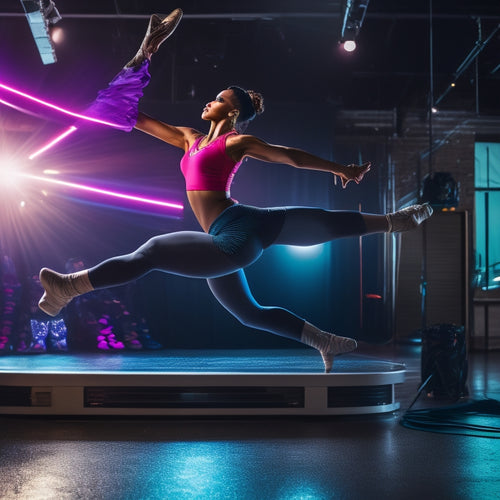
Navigating Tattoos in Dance: Empowering Artistic Expression
Share
Dancers with tattoos navigate a intricate landscape where artistic expression meets industry standards. The visibility of their tattoos notably impacts their professional image, influencing perception and personal branding. While tattoos are a form of self-expression, awareness of potential consequences in conservative genres is essential. Breaking down tattoo stigma in dance communities requires understanding societal biases and varying comfort levels across genres. Empowering tattooed dancers to express themselves fosters a culture of acceptance, allowing them to channel their energy into perfecting their craft. By embracing tattoos as a form of artistic expression, dancers can overcome barriers to creativity, and that's just the beginning.
Key Takeaways
• Tattoos in dance should not hinder artistic expression, but rather be embraced as a form of self-expression and personal branding.
• Understanding industry standards and societal perceptions is crucial for tattooed dancers to navigate different dance genres.
• Temporary tattoo coverage options, strategic placement, and makeup techniques can help minimize visibility in conservative genres.
• Fostering inclusive dance spaces that celebrate unique characteristics and empower tattooed dancers to express themselves authentically.
• By overcoming tattoo-related barriers, dancers can channel their energy into perfecting their craft and elevating their artistic expression.
Tattoos and Professional Image
Dancers often struggle with the impact of tattoos on their professional image, as the visibility of tattoos can influence how they're perceived by choreographers, directors, and audiences alike.
When considering tattoos, dancers must think about their personal branding and how it aligns with industry standards. A tattoo can be seen as a form of self-expression, but it can also be viewed as unprofessional or distracting.
Dancers should weigh the potential consequences of having visible tattoos, particularly in conservative genres like classical ballet. By understanding the potential impact of tattoos on their professional image, dancers can make informed decisions that align with their personal and artistic goals.
This awareness is essential in navigating the complex relationship between tattoos and professional success in the dance industry.
Breaking Down Tattoo Stigma
What underlying biases and cultural norms perpetuate the stigma surrounding tattoos in certain dance communities? To break down this stigma, grasping the complexities of societal perceptions and hidden biases is crucial. The table below highlights the varying comfort levels and personal experiences of dancers with tattoos in different settings.
| Dance Genre | Tattoo Prevalence | Comfort Levels |
|---|---|---|
| Ballet | Low | Uncomfortable |
| Contemporary | Medium | Neutral |
| Hip-Hop | High | Comfortable |
Coverage Options and Considerations
When considering tattoo coverage, dancers must navigate a range of options, from temporary solutions like tattoo cover-up tape and makeup to more permanent choices like strategic tattoo placement.
Temporary solutions offer flexibility, allowing dancers to adapt to different performance requirements. Makeup techniques, such as layering and color-matching, can effectively conceal tattoos. However, these methods require skill, practice, and time.
Strategic tattoo placement, on the other hand, involves thoughtful consideration during the tattoo design process to minimize visibility. This approach can reduce the need for extensive coverage, making it a valuable consideration for dancers.
Fostering Inclusive Dance Spaces
By embracing a culture of acceptance and inclusivity, dance studios and companies can create environments where tattooed dancers feel empowered to express themselves authentically. A supportive community fosters a non-judgmental atmosphere, allowing dancers to feel comfortable in their own skin.
Embracing individuality is key, as it encourages dancers to celebrate their unique characteristics, including their tattoos. This inclusive environment promotes self-expression, allowing dancers to focus on their craft rather than concealing their tattoos.
Empowering Authentic Expression
Authentic expression flourishes when dancers, unencumbered by the need to conceal their tattoos, can channel their energy into perfecting their craft.
By embracing individuality, dancers can overcome barriers that may have previously stifled their creativity. Self-expression is elevated when tattoos are no longer seen as obstacles, but rather as integral parts of a dancer's identity.
Empowerment through ink allows dancers to embody their true selves, unapologetically. As a result, artistic expression becomes more genuine, and performances more enchanting.
Frequently Asked Questions
Can I Get a Tattoo in a Visible Area as a Professional Dancer?
She contemplates the professional boundaries of her dance career before getting a tattoo in a visible area, weighing the potential impact on her image and opportunities, and evaluating the current level of tattoo acceptance in her industry.
Are There Any Dance Companies That Openly Accept Tattooed Dancers?
Like a canvas awaiting vibrant brushstrokes, the dance world slowly unfolds to embrace tattooed artists. Inclusive companies, such as the Martha Graham Dance Company, celebrate individuality, allowing dancers to express themselves authentically, fostering an environment where artistic expression knows no bounds.
How Do I Balance Self-Expression With Potential Career Limitations?
She weighs career decisions against personal freedoms, considering how body art may impact professional boundaries, and carefully navigates self-expression to guarantee it doesn't compromise her career aspirations, finding a balance that resonates with her artistic identity.
What Are the Most Common Tattoo Cover-Up Mistakes in Dance Performances?
She skillfully sidesteps sloppy slip-ups by avoiding distractions, maintaining professionalism, and considering costume complexities, ensuring that her tattoo cover-up techniques don't compromise her performance impact, allowing her to shine on stage with confidence.
Can I Still Get Hired as a Dance Instructor With Visible Tattoos?
She can still get hired as a dance instructor with visible tattoos, but it depends on the employer's policies and instructor qualifications, as some may impose tattoo placement restrictions or have specific dress code requirements.
Related Posts
-

10 Essential Digital Product Creation Tips for Makeup Artists
You're ready to harness your makeup artistry skills into a thriving digital business. To get started, identify your t...
-

Take Your Dance Skills to the Next Level With These Accessories
You're ready to take your dance skills to the next level! With the right accessories, you can access new styles, impr...
-

Ballet Cut File Set: Versatile Designs Available
The Ballet Cut File Set offers a wide-ranging collection of versatile designs available in multiple formats, includin...


